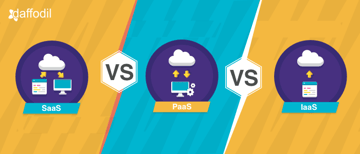
In a survey conducted by 451 Research, 69% of the respondents said that they are planning to have a multi-cloud environment by 2019; highlighting that multi-cloud and hybrid is the future of IT.
“A multi-cloud strategy involves the use of two or more cloud computing services, such as AWS, Google Cloud, or Microsoft Azure. On the other hand, a multi-cloud deployment refers to the implementation of multiple SaaS or PaaS offerings for an application, offered by different cloud computing service.”
While businesses swear by the benefits of cloud, they are acknowledging the added advantages that multi-cloud adoption offers. Vendor lock-in savior, data sovereignty, increased redundancy, controlled cost are a few of them. The later segment details some of the major drivers of multi-cloud adoption and how it can help businesses save cost, improve efficiency, and mitigate risks.
Understanding Cloud Environment and Distinguishing Between Them
Getting started with cloud technology requires reasonable decision making. Whether to opt for hybrid cloud, private or public cloud, single or multi-cloud are some of the base factors that define ROI. Let us understand the basic difference between these different cloud environments.
Single VS Multi-Cloud Environment: When choosing a single cloud environment, a business basically avails the services rendered by one cloud service provider. In this case, all cloud services, whether SaaS, PaaS are availed from a single provider like AWS, Azure, or Google Cloud. In a multi-cloud strategy, on the other hand, the business utilizes the best of services from different cloud service providers. For example, Lambda for scalability by AWS, cognitive services by Azure, and so on.
Private VS Public Cloud: A private cloud (also known as Internal or corporate cloud), are computing services that are offered over the internet or a private internal network. Private cloud offers an extra level of security and privacy through company firewalls and internal hosting. This ascertains that sensitive data of a business is not accessible to any third party service provider. However, organizations with a private cloud take ownership of data center management and maintenance.
A public cloud is a computing service where the provider makes the resources available to the public via the internet. This type of cloud service is quite popular amongst businesses of all types as it provides quick access to new products and services, without having to take care of their setup and maintenance.
Hybrid Cloud: A hybrid cloud is a mix of on-premises, private cloud, and public cloud services with orchestration between the two parties. In this case, organizations utilize the best of both the worlds-private and public cloud.
ALSO READ: On-Premise to AWS Migration: Know Why and How to do it?
Why Should Businesses Adopt Multi-Cloud Strategy?
Making a choice between varied cloud environments simply depends upon a business requirement. Startups and SMEs who have just started using cloud services can opt for a single cloud environment for one or more services. This not only helps save the infrastructure cost but also provides support to businesses that are less technically adept.
However, as the requirement extends, it is a good practice to navigate through different cloud service providers to have access to a range of tools, SaaS, PaaS options. This is where a multi-cloud strategy plays an important role. The diversity in cloud platforms and services provides other lines of benefits, such as:
High Resiliency: Every cloud platform have a unique strength. Amazon’s AWS has the lowest compute cost, Azure has a strong enterprise presence, while Google GCP is known for analytics solutions. Opting for the multi-cloud system means there is flexibility to choose from a variety of services, whichever suits or works well according to the business needs.
Vendor Lock-in Savior: Vendor lock-in, in general, is the restricted use of technology, solution or service, developed by a vendor or a vendor partner. In cloud computing, vendor lock-in is the inability of a business to switch to another cloud to avail better functionality, features, and benefits that they offer. Adopting a multi-cloud strategy saves businesses from vendor lock-in situations.
Data Sovereignty: Digital data is increasing by multi-folds each day. To protect customer data from breaches, businesses are made to follow regulations and compliances. Europe’s GDPR, China’s CSL, Brazil’s LGPD, India’s Data Protection Bill, and there are others that need to be followed. A multi-cloud strategy allows businesses to opt for platforms that offer the most relevant infra and software to comply with the regulations.
Cost Cut-Down: One of the major drivers of cloud adoption is reduced OpEx and CapEx cost. When following the multi-cloud approach, there is an opportunity to compare service prices by each service provider and choose the one available at optimal cost.
Multi-Cloud Strategy for your Business: Challenges Involved
While opting for multiple cloud providers and services have a number of benefits to offer, getting started with it can put forth some challenges. Migrating services from one platform to another, ensuring their performance, security, cost comparison in accordance with efficiency are some of the factors that need consideration before adopting a multi-cloud strategy for any business.
At Daffodil, we strongly recommend a multi-cloud system to our clients for cost and efficiency benefits. A number of projects being implemented at cloud are following the multi-cloud strategy and have we have happy clients in consequence. If your business is switching from a single to multi-cloud system, then set up a 30-minute free consultation with our cloud expert, Gaurav Sharma to understand the best deployment and migration practices for maximum ROI.



